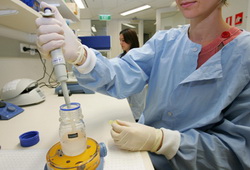In vitro fertilization (IVF) treatment consists of several steps which are performed to achieve pregnancy. The IVF cycles refer to the whole process of IVF treatment. One round of the IVF treatment is called the IVF cycle. There are five steps in IVF cycles namely, ovarian stimulation, egg retrieval, insemination, fertilization and culture, and embryo transfer.

IVF cycles: Ovarian Stimulation
The first step in all IVF cycles is ovarian stimulation. The purpose of this step is to encourage the development of more mature eggs for retrieval and fertilization. In the ovulation stimulation, the patient is treated with medications to suppress ovulation. This will somehow stimulate the ovaries to produce more eggs for fertilization. Two injectable medications are used during ovulation induction, Lupron and gonadotropin. Lupron suppresses normal ovulation until the exact moment. The gonadotropin encourages the ovaries to produce numerous eggs for fertilization rather than the usual single egg. After receiving injections, the patient will undergo blood tests and tansvaginal ultrasound to trace maturation of the eggs.
In the transvaginal ultrasound, high frequency sound waves are transmitted through the tissues. As the ultrasound waves hit the tissue, a white image will be seen on the screen which will show the appearance of follicles in dark circles.
Blood tests are taken to determine the patient's estradiol level. Estradiol is generated by the lining of the follicles. If the patient is ready for retrieval, an injection will be given to ripen the eggs that are developing and will also initiate ovulation. If the patient does not have egg-retrieval procedure, ovulation will happen around 42 to 48 hours from the time of injection.
IVF cycles: Egg Retrieval
The next stage of IVF cycles is egg retrieval. Before retrieval, the patient should abstain from eating and drinking for a period of eight hours. When the eggs become mature, these will be retrieved while the patient is sedated. An ultrasound probe guides the long needle to extract the fluid which contains the eggs from the follicles of the ovaries that have developed.
IVF cycles: Insemination
When the process of egg retrieval has been completed, the next step of IVF cycle is insemination. The eggs of the woman and the sperm will be combined in vitro.
IVF cycles: Fertilization and Culture, Transfer
After insemination, fertilization and culture takes place. Fertilization of the eggs will be carried in a laboratory setting. The eggs are placed in a Petri dish along with thousands of sperms and left overnight for fertilization to take place. The following morning, the eggs are checked if there is fertilization and during the afternoon eggs will be checked again if cell division has occurred. If there is cell division, the eggs become embryos and are placed in a media solution to promote growth. The embryo can be transferred into the woman's uterus with exact timing which is after three to six days of growth.
Below shows the timeline of administering IVF cycles:
- Birth Control Pills - approximately 14 to 21 days
- Lupron - 12 to 15 days
- Transvaginal Ultrasound stimulation – approximately 10 to 12 days
- Trigger shot
- Egg Retrieval - 36 to 37 hours after trigger shot
- Embryo Transfer- 3 to 5 days after retrieval
- Pregnancy Test - 14 days after retrieval
